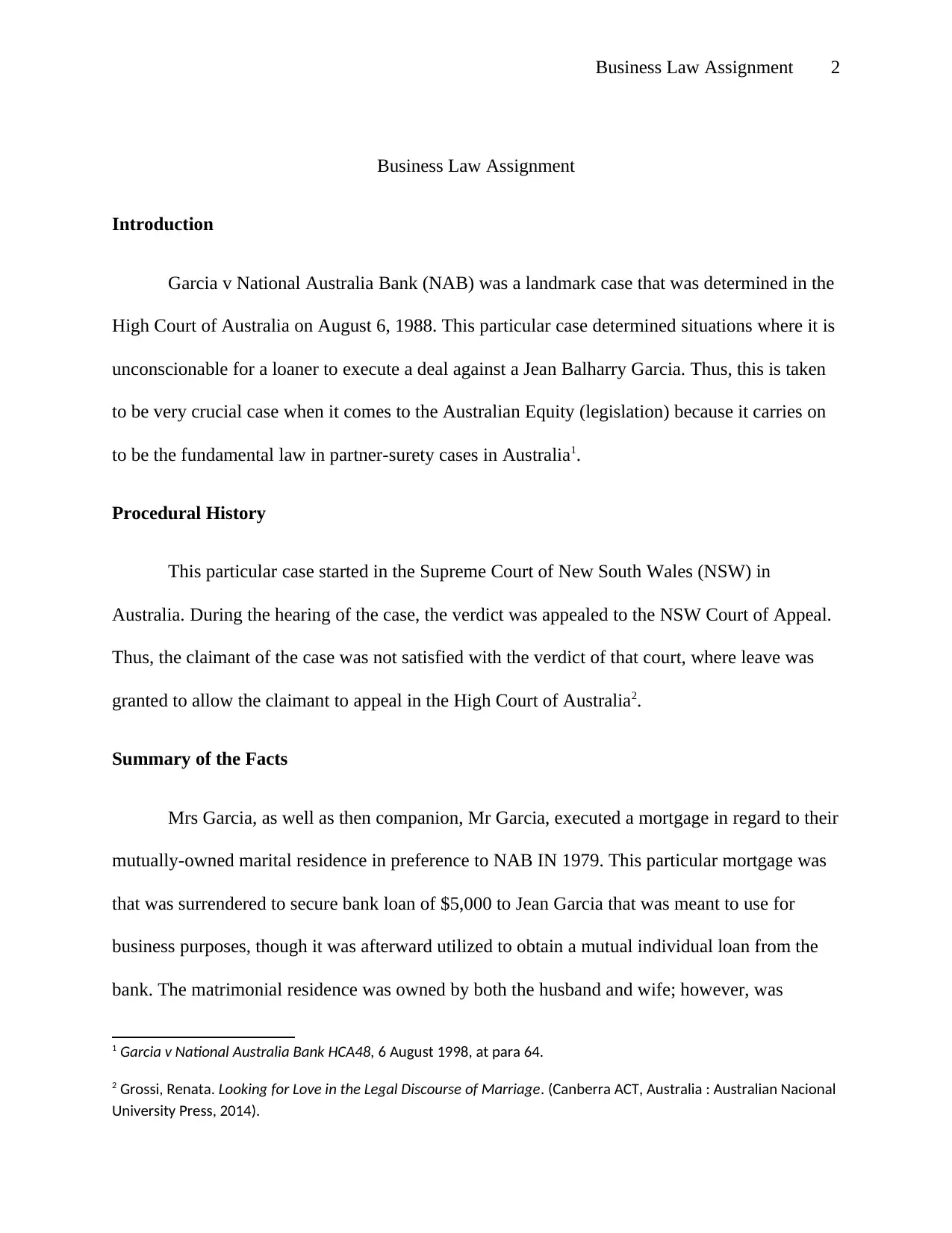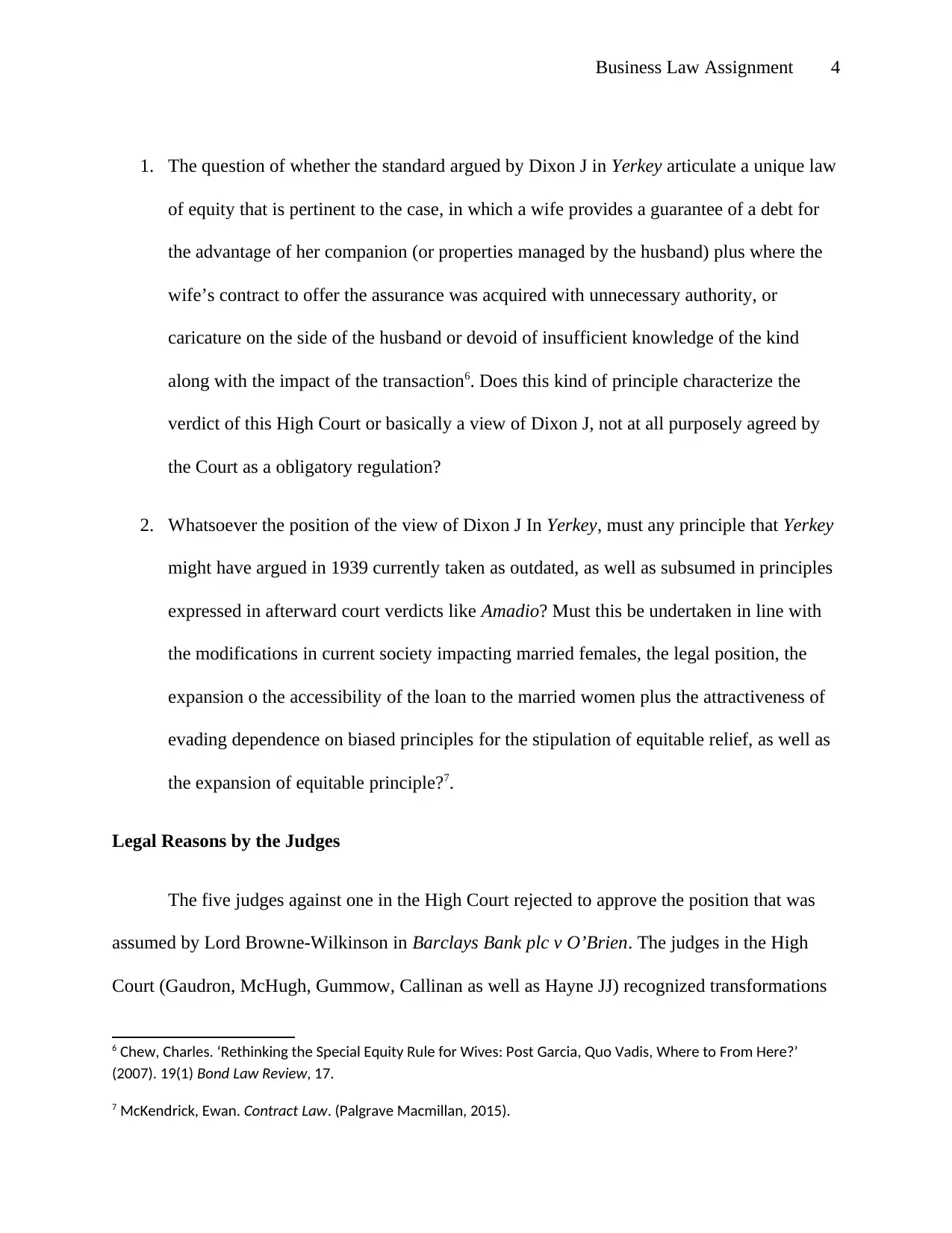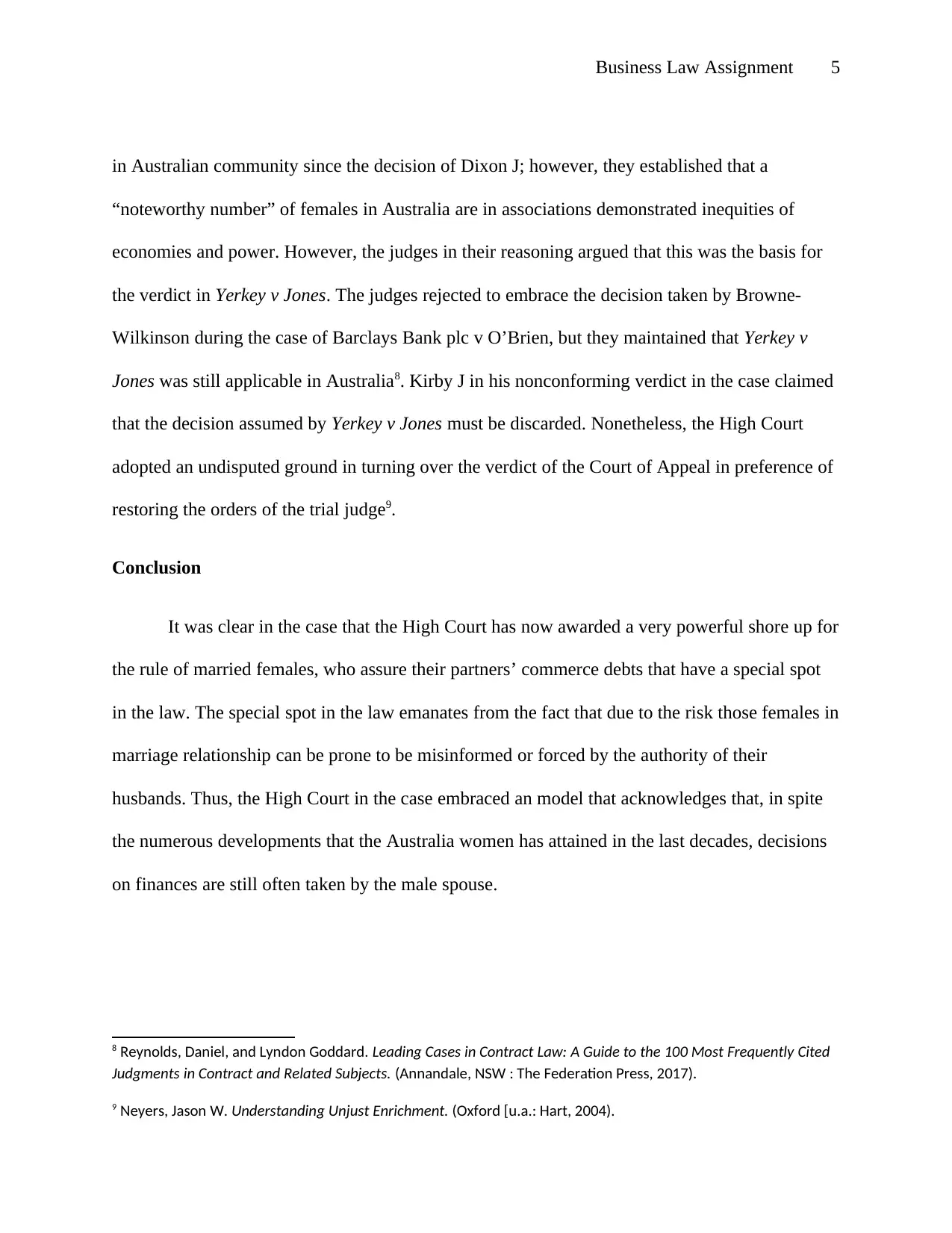Garcia v National Australia Bank: A Landmark Case in Australian Equity
VerifiedAdded on 2023/06/04
|7
|1530
|428
AI Summary
This article discusses the landmark case of Garcia v National Australia Bank and its impact on Australian Equity. It covers the procedural history, summary of facts, legal issues, and legal reasons by the judges. The case established situations where it is unconscionable for a loaner to execute a deal against a partner-surety. The article also discusses the special spot in the law that married females have when it comes to assuring their partners' commerce debts.
Contribute Materials
Your contribution can guide someone’s learning journey. Share your
documents today.

Business Law Assignment 1
Business Law Assignment
Name
Course
Institution
Instructor
Date
Business Law Assignment
Name
Course
Institution
Instructor
Date
Secure Best Marks with AI Grader
Need help grading? Try our AI Grader for instant feedback on your assignments.

Business Law Assignment 2
Business Law Assignment
Introduction
Garcia v National Australia Bank (NAB) was a landmark case that was determined in the
High Court of Australia on August 6, 1988. This particular case determined situations where it is
unconscionable for a loaner to execute a deal against a Jean Balharry Garcia. Thus, this is taken
to be very crucial case when it comes to the Australian Equity (legislation) because it carries on
to be the fundamental law in partner-surety cases in Australia1.
Procedural History
This particular case started in the Supreme Court of New South Wales (NSW) in
Australia. During the hearing of the case, the verdict was appealed to the NSW Court of Appeal.
Thus, the claimant of the case was not satisfied with the verdict of that court, where leave was
granted to allow the claimant to appeal in the High Court of Australia2.
Summary of the Facts
Mrs Garcia, as well as then companion, Mr Garcia, executed a mortgage in regard to their
mutually-owned marital residence in preference to NAB IN 1979. This particular mortgage was
that was surrendered to secure bank loan of $5,000 to Jean Garcia that was meant to use for
business purposes, though it was afterward utilized to obtain a mutual individual loan from the
bank. The matrimonial residence was owned by both the husband and wife; however, was
1 Garcia v National Australia Bank HCA48, 6 August 1998, at para 64.
2 Grossi, Renata. Looking for Love in the Legal Discourse of Marriage. (Canberra ACT, Australia : Australian Nacional
University Press, 2014).
Business Law Assignment
Introduction
Garcia v National Australia Bank (NAB) was a landmark case that was determined in the
High Court of Australia on August 6, 1988. This particular case determined situations where it is
unconscionable for a loaner to execute a deal against a Jean Balharry Garcia. Thus, this is taken
to be very crucial case when it comes to the Australian Equity (legislation) because it carries on
to be the fundamental law in partner-surety cases in Australia1.
Procedural History
This particular case started in the Supreme Court of New South Wales (NSW) in
Australia. During the hearing of the case, the verdict was appealed to the NSW Court of Appeal.
Thus, the claimant of the case was not satisfied with the verdict of that court, where leave was
granted to allow the claimant to appeal in the High Court of Australia2.
Summary of the Facts
Mrs Garcia, as well as then companion, Mr Garcia, executed a mortgage in regard to their
mutually-owned marital residence in preference to NAB IN 1979. This particular mortgage was
that was surrendered to secure bank loan of $5,000 to Jean Garcia that was meant to use for
business purposes, though it was afterward utilized to obtain a mutual individual loan from the
bank. The matrimonial residence was owned by both the husband and wife; however, was
1 Garcia v National Australia Bank HCA48, 6 August 1998, at para 64.
2 Grossi, Renata. Looking for Love in the Legal Discourse of Marriage. (Canberra ACT, Australia : Australian Nacional
University Press, 2014).

Business Law Assignment 3
erected on parcel of land that had been bought by Jean with monetary assistance from her father.
Thus, NAB had emphasized that the land be placed in the names of Mrs and Mr Garcia when the
residence was being erected. This meant that there could be a “wage earner” on the land title
deed. However, between 1985 and 195, the wife signed 4 guarantees that were in the preference
of the NAB. Three of the FOUE guarantees signed by Mrs Garcia concerned Mr Garcia’s
business, Citizens Gold, as well as one other company. The guarantee that was made in
November 1987 was restricted to $270,000 together with interest, expenses, as well as charges3.
Mr and Mrs Garcia divorced in September 1988 while in October 1989; there was a
court order that winded Citizens Gold. In addition, Mr Garcia was served with an order nisi in
November 1989 that became unconditional in 19904. Proceedings started in June 1990 in the
highest court in Australia that the mortgage plus guarantees were regarded as null and void. Mr
Garcia sought relief based on the doctrines of Yerkey v Jones and Commercial Bank of Australia
v Amadio (Amadio) and founded on Contract Review Act of 1988 (New South Wales). It was in
August 1990 that the NAB demanded payment based on November 1987 guarantee along with
the mortgage for monies owing by Citizens Gold5.
Summary of the Issues
In the Garcia v NAB case, there were three primary legal issues:
3 Murray Brown. ‘The Garcia Code’. (2003) 14 Journal of Banking and Finance Law and Practice, 17, 21.
4 Barrett, Patrick. Summary Judgment in Ireland: Principles and Defences. (Haywards Heath : Bloomsbury
Professional, 2013).
5 Garcia v National Australia Bank
erected on parcel of land that had been bought by Jean with monetary assistance from her father.
Thus, NAB had emphasized that the land be placed in the names of Mrs and Mr Garcia when the
residence was being erected. This meant that there could be a “wage earner” on the land title
deed. However, between 1985 and 195, the wife signed 4 guarantees that were in the preference
of the NAB. Three of the FOUE guarantees signed by Mrs Garcia concerned Mr Garcia’s
business, Citizens Gold, as well as one other company. The guarantee that was made in
November 1987 was restricted to $270,000 together with interest, expenses, as well as charges3.
Mr and Mrs Garcia divorced in September 1988 while in October 1989; there was a
court order that winded Citizens Gold. In addition, Mr Garcia was served with an order nisi in
November 1989 that became unconditional in 19904. Proceedings started in June 1990 in the
highest court in Australia that the mortgage plus guarantees were regarded as null and void. Mr
Garcia sought relief based on the doctrines of Yerkey v Jones and Commercial Bank of Australia
v Amadio (Amadio) and founded on Contract Review Act of 1988 (New South Wales). It was in
August 1990 that the NAB demanded payment based on November 1987 guarantee along with
the mortgage for monies owing by Citizens Gold5.
Summary of the Issues
In the Garcia v NAB case, there were three primary legal issues:
3 Murray Brown. ‘The Garcia Code’. (2003) 14 Journal of Banking and Finance Law and Practice, 17, 21.
4 Barrett, Patrick. Summary Judgment in Ireland: Principles and Defences. (Haywards Heath : Bloomsbury
Professional, 2013).
5 Garcia v National Australia Bank

Business Law Assignment 4
1. The question of whether the standard argued by Dixon J in Yerkey articulate a unique law
of equity that is pertinent to the case, in which a wife provides a guarantee of a debt for
the advantage of her companion (or properties managed by the husband) plus where the
wife’s contract to offer the assurance was acquired with unnecessary authority, or
caricature on the side of the husband or devoid of insufficient knowledge of the kind
along with the impact of the transaction6. Does this kind of principle characterize the
verdict of this High Court or basically a view of Dixon J, not at all purposely agreed by
the Court as a obligatory regulation?
2. Whatsoever the position of the view of Dixon J In Yerkey, must any principle that Yerkey
might have argued in 1939 currently taken as outdated, as well as subsumed in principles
expressed in afterward court verdicts like Amadio? Must this be undertaken in line with
the modifications in current society impacting married females, the legal position, the
expansion o the accessibility of the loan to the married women plus the attractiveness of
evading dependence on biased principles for the stipulation of equitable relief, as well as
the expansion of equitable principle?7.
Legal Reasons by the Judges
The five judges against one in the High Court rejected to approve the position that was
assumed by Lord Browne-Wilkinson in Barclays Bank plc v O’Brien. The judges in the High
Court (Gaudron, McHugh, Gummow, Callinan as well as Hayne JJ) recognized transformations
6 Chew, Charles. ‘Rethinking the Special Equity Rule for Wives: Post Garcia, Quo Vadis, Where to From Here?’
(2007). 19(1) Bond Law Review, 17.
7 McKendrick, Ewan. Contract Law. (Palgrave Macmillan, 2015).
1. The question of whether the standard argued by Dixon J in Yerkey articulate a unique law
of equity that is pertinent to the case, in which a wife provides a guarantee of a debt for
the advantage of her companion (or properties managed by the husband) plus where the
wife’s contract to offer the assurance was acquired with unnecessary authority, or
caricature on the side of the husband or devoid of insufficient knowledge of the kind
along with the impact of the transaction6. Does this kind of principle characterize the
verdict of this High Court or basically a view of Dixon J, not at all purposely agreed by
the Court as a obligatory regulation?
2. Whatsoever the position of the view of Dixon J In Yerkey, must any principle that Yerkey
might have argued in 1939 currently taken as outdated, as well as subsumed in principles
expressed in afterward court verdicts like Amadio? Must this be undertaken in line with
the modifications in current society impacting married females, the legal position, the
expansion o the accessibility of the loan to the married women plus the attractiveness of
evading dependence on biased principles for the stipulation of equitable relief, as well as
the expansion of equitable principle?7.
Legal Reasons by the Judges
The five judges against one in the High Court rejected to approve the position that was
assumed by Lord Browne-Wilkinson in Barclays Bank plc v O’Brien. The judges in the High
Court (Gaudron, McHugh, Gummow, Callinan as well as Hayne JJ) recognized transformations
6 Chew, Charles. ‘Rethinking the Special Equity Rule for Wives: Post Garcia, Quo Vadis, Where to From Here?’
(2007). 19(1) Bond Law Review, 17.
7 McKendrick, Ewan. Contract Law. (Palgrave Macmillan, 2015).
Secure Best Marks with AI Grader
Need help grading? Try our AI Grader for instant feedback on your assignments.

Business Law Assignment 5
in Australian community since the decision of Dixon J; however, they established that a
“noteworthy number” of females in Australia are in associations demonstrated inequities of
economies and power. However, the judges in their reasoning argued that this was the basis for
the verdict in Yerkey v Jones. The judges rejected to embrace the decision taken by Browne-
Wilkinson during the case of Barclays Bank plc v O’Brien, but they maintained that Yerkey v
Jones was still applicable in Australia8. Kirby J in his nonconforming verdict in the case claimed
that the decision assumed by Yerkey v Jones must be discarded. Nonetheless, the High Court
adopted an undisputed ground in turning over the verdict of the Court of Appeal in preference of
restoring the orders of the trial judge9.
Conclusion
It was clear in the case that the High Court has now awarded a very powerful shore up for
the rule of married females, who assure their partners’ commerce debts that have a special spot
in the law. The special spot in the law emanates from the fact that due to the risk those females in
marriage relationship can be prone to be misinformed or forced by the authority of their
husbands. Thus, the High Court in the case embraced an model that acknowledges that, in spite
the numerous developments that the Australia women has attained in the last decades, decisions
on finances are still often taken by the male spouse.
8 Reynolds, Daniel, and Lyndon Goddard. Leading Cases in Contract Law: A Guide to the 100 Most Frequently Cited
Judgments in Contract and Related Subjects. (Annandale, NSW : The Federation Press, 2017).
9 Neyers, Jason W. Understanding Unjust Enrichment. (Oxford [u.a.: Hart, 2004).
in Australian community since the decision of Dixon J; however, they established that a
“noteworthy number” of females in Australia are in associations demonstrated inequities of
economies and power. However, the judges in their reasoning argued that this was the basis for
the verdict in Yerkey v Jones. The judges rejected to embrace the decision taken by Browne-
Wilkinson during the case of Barclays Bank plc v O’Brien, but they maintained that Yerkey v
Jones was still applicable in Australia8. Kirby J in his nonconforming verdict in the case claimed
that the decision assumed by Yerkey v Jones must be discarded. Nonetheless, the High Court
adopted an undisputed ground in turning over the verdict of the Court of Appeal in preference of
restoring the orders of the trial judge9.
Conclusion
It was clear in the case that the High Court has now awarded a very powerful shore up for
the rule of married females, who assure their partners’ commerce debts that have a special spot
in the law. The special spot in the law emanates from the fact that due to the risk those females in
marriage relationship can be prone to be misinformed or forced by the authority of their
husbands. Thus, the High Court in the case embraced an model that acknowledges that, in spite
the numerous developments that the Australia women has attained in the last decades, decisions
on finances are still often taken by the male spouse.
8 Reynolds, Daniel, and Lyndon Goddard. Leading Cases in Contract Law: A Guide to the 100 Most Frequently Cited
Judgments in Contract and Related Subjects. (Annandale, NSW : The Federation Press, 2017).
9 Neyers, Jason W. Understanding Unjust Enrichment. (Oxford [u.a.: Hart, 2004).

Business Law Assignment 6
Bibliography
Barrett, Patrick. Summary Judgment in Ireland: Principles and Defences. (Haywards Heath :
Bloomsbury Professional, 2013).
Chew, Charles. Rethinking the Special Equity Rule for Wives: Post Garcia, Quo Vadis, Where to
From Here? (2007). 19(1) Bond Law Review, 17.
Garcia v National Australia Bank HCA48, 6 August 1998, at para 64.
Grossi, Renata. Looking for Love in the Legal Discourse of Marriage. (Canberra ACT, Australia
: Australian Nacional University Press, 2014).
McKendrick, Ewan. Contract Law. (Palgrave Macmillan, 2015).
Murray Brown. ‘The Garcia Code’. (2003) 14 Journal of Banking and Finance Law and
Practice, 17, 21.
Neyers, Jason W. Understanding Unjust Enrichment. (Oxford [u.a.: Hart, 2004).
Reynolds, Daniel, and Lyndon Goddard. Leading Cases in Contract Law: A Guide to the 100
Most Frequently Cited Judgments in Contract and Related Subjects. (Annandale, NSW :
The Federation Press, 2017).
Bibliography
Barrett, Patrick. Summary Judgment in Ireland: Principles and Defences. (Haywards Heath :
Bloomsbury Professional, 2013).
Chew, Charles. Rethinking the Special Equity Rule for Wives: Post Garcia, Quo Vadis, Where to
From Here? (2007). 19(1) Bond Law Review, 17.
Garcia v National Australia Bank HCA48, 6 August 1998, at para 64.
Grossi, Renata. Looking for Love in the Legal Discourse of Marriage. (Canberra ACT, Australia
: Australian Nacional University Press, 2014).
McKendrick, Ewan. Contract Law. (Palgrave Macmillan, 2015).
Murray Brown. ‘The Garcia Code’. (2003) 14 Journal of Banking and Finance Law and
Practice, 17, 21.
Neyers, Jason W. Understanding Unjust Enrichment. (Oxford [u.a.: Hart, 2004).
Reynolds, Daniel, and Lyndon Goddard. Leading Cases in Contract Law: A Guide to the 100
Most Frequently Cited Judgments in Contract and Related Subjects. (Annandale, NSW :
The Federation Press, 2017).

Business Law Assignment 7
1 out of 7
Your All-in-One AI-Powered Toolkit for Academic Success.
+13062052269
info@desklib.com
Available 24*7 on WhatsApp / Email
![[object Object]](/_next/static/media/star-bottom.7253800d.svg)
Unlock your academic potential
© 2024 | Zucol Services PVT LTD | All rights reserved.

